Table of Contents
Have you ever found yourself caught in the endless cycle of racing thoughts, feeling like your mind is a browser with 47 tabs open? You’re not alone. In our always-connected world, stress has become our unwelcome companion, and mindful meditation benefits are becoming more crucial than ever for finding that elusive sense of peace.
Picture this: you’re sitting in traffic, already running late, and you can feel your shoulders creeping toward your ears while your jaw clenches. This is where the magic of mindful meditation steps in – not as some mystical practice reserved for monks on mountaintops, but as a practical, accessible tool that can transform these moments of chaos into opportunities for calm.
Mindful meditation isn’t just another wellness trend that’ll fade away. It’s a time-tested practice rooted in over 2,500 years of wisdom, now backed by solid scientific research that proves its effectiveness in reducing stress, improving mental clarity, and enhancing overall well-being. The beauty lies in its simplicity – you don’t need special equipment, expensive memberships, or hours of free time. All you need is a willingness to pause, breathe, and be present.
What Is Mindful Meditation and Why Does It Work?
Let’s get real about what mindful meditation actually is. At its core, it’s the practice of paying attention to the present moment without getting caught up in judgment or trying to change anything. Think of it as becoming the curious observer of your own experience rather than being swept away by every thought and emotion that passes through your mind.
The science behind why this works is pretty fascinating. When we practice mindfulness, we’re essentially training our brain to recognize the difference between being present and being lost in mental chatter. This creates what researchers call a “response space” – that crucial pause between stimulus and reaction that allows us to choose how we respond rather than simply react automatically.
Your brain on mindfulness looks different too. Neuroimaging studies have shown that regular meditation practice actually changes brain structure, particularly in areas associated with attention regulation and emotional processing. The amygdala – your brain’s alarm system – becomes less reactive, while the prefrontal cortex – responsible for executive function and emotional regulation – becomes more active and connected.
The Science-Backed Benefits of Mindful Meditation

The research on mindful meditation benefits is pretty compelling. Let’s dive into what the studies actually show us, because understanding the ‘why’ behind the practice can be incredibly motivating.
Stress Reduction That Actually Works
One of the most well-documented benefits is stress reduction, and we’re not talking about just feeling slightly more relaxed. Regular mindfulness practice can actually lower cortisol levels – that’s your body’s main stress hormone. Studies show that mindfulness-based stress reduction programs can lead to significant improvements in both psychological and physical symptoms of stress.
What’s happening here is pretty remarkable. Instead of your nervous system staying stuck in fight-or-flight mode, mindfulness helps activate your parasympathetic nervous system – the “rest and digest” response. This means lower blood pressure, improved heart rate variability, and better sleep quality.
Mental Health Improvements
The mental health benefits extend far beyond just stress relief. Research from the American Psychological Association demonstrates that mindfulness-based cognitive therapy can be as effective as antidepressant medication for preventing depression relapse. That’s huge.
For anxiety management, mindfulness offers a different approach than trying to fight or suppress anxious thoughts. Instead, it teaches you to observe these thoughts with curiosity rather than getting trapped by them. This shift in relationship to your inner experience can be genuinely life-changing.
Enhanced Focus and Cognitive Function
In our age of constant distractions, the ability to focus has become almost a superpower. Mindfulness meditation literally strengthens your attention muscle. Studies indicate that even short-term mindfulness training can improve working memory, reduce mind-wandering, and enhance cognitive flexibility.
This isn’t just about being more productive at work (though that’s a nice side effect). It’s about being more present in your relationships, more engaged in activities you enjoy, and less likely to get lost in the endless scroll of social media.
Better Sleep Quality
If you’re someone who lies awake replaying the day’s events or worrying about tomorrow’s to-do list, mindfulness can be a game-changer. The practice helps quiet the mental chatter that often keeps us awake. Plus, the stress reduction benefits naturally translate into better sleep quality.
Many people find that a short mindfulness practice before bed helps signal to their nervous system that it’s time to wind down. It’s like giving your mind permission to transition from “doing mode” to “being mode.”
Different Types of Mindful Meditation Practices
The beautiful thing about mindfulness is that there’s no one-size-fits-all approach. Different practices work better for different people, and what resonates with you might change over time.
Breath-Focused Meditation
This is probably the most accessible starting point. You simply focus your attention on your breath – the sensation of air moving in and out of your nostrils, the rise and fall of your chest, or the pause between inhale and exhale. When your mind wanders (and it will), you gently bring your attention back to the breath.
The breath is always available to you, making this practice incredibly portable. Stuck in a meeting that’s going nowhere? You can practice breath awareness. Feeling overwhelmed at the grocery store? Three mindful breaths can help reset your nervous system.
Body Scan Meditation
This practice involves systematically bringing attention to different parts of your body, usually starting from the toes and working your way up to the head. It’s particularly effective for releasing physical tension and developing greater body awareness.
Many people are surprised to discover how much tension they’ve been carrying without realizing it. A body scan can help you identify these patterns and learn to release them consciously.

Walking Meditation
For those who find sitting still challenging, walking meditation offers a wonderful alternative. This can be done indoors in a small space or outdoors in nature. The key is to walk slowly and deliberately, paying attention to the sensations of each step.
This practice beautifully illustrates how mindfulness can be integrated into daily activities. Every time you walk from one room to another, you have an opportunity to practice presence.
Loving-Kindness Meditation
This practice involves directing well-wishes toward yourself and others. You might start with phrases like “May I be happy, may I be healthy, may I be at peace,” then extend these wishes to loved ones, neutral people, difficult people, and eventually all beings.
Research shows that loving-kindness meditation can increase positive emotions, enhance social connectedness, and even increase telomerase activity (associated with cellular health and longevity).
How to Start Your Mindful Meditation Practice
Starting a meditation practice doesn’t have to be overwhelming. In fact, the simpler you keep it initially, the more likely you’ll stick with it. Here’s a realistic approach that actually works for busy people.
Start Small and Be Consistent
Forget about sitting for an hour in perfect lotus position. Start with just 5 minutes a day. Seriously. Consistency trumps duration every single time. It’s better to meditate for 5 minutes daily for a month than to do one 30-minute session and then skip the next two weeks.
Choose a specific time of day and stick to it. Many people find that morning works well because it sets a calm tone for the day, but the best time is whatever time you can actually commit to consistently.
Create a Simple Setup
You don’t need a dedicated meditation room or fancy cushions (though if those things motivate you, go for it). Find a quiet spot where you won’t be interrupted. If you have kids, this might be your car in the driveway or the bathroom with the door locked. No judgment here – we work with what we’ve got.
Sit comfortably with your back straight but not rigid. You can use a chair, cushion, or even lie down if sitting is uncomfortable. The key is finding a position you can maintain for your chosen duration without fidgeting too much.
Use Guided Meditations Initially
There’s no shame in needing guidance when you’re starting out. Apps like Headspace, Calm, or Insight Timer offer excellent beginner programs. Having someone guide you through the process can help you understand what you’re supposed to be doing and provide structure for your practice.
As you become more comfortable, you might choose to practice in silence, but guided meditations remain valuable even for experienced practitioners.
Be Patient with Your Wandering Mind
Here’s the thing nobody tells you: a “wandering mind” isn’t a meditation failure – it’s literally the point. The practice isn’t about having no thoughts; it’s about noticing when your mind has wandered and gently bringing your attention back to your chosen focus.
Every time you notice you’ve been thinking and return to your breath (or whatever your anchor is), you’re actually succeeding at meditation. That moment of awareness is exactly what you’re cultivating.
Overcoming Common Meditation Challenges

Let’s address some of the roadblocks that trip people up, because chances are you’ll encounter at least one of these.
“I Don’t Have Time”
This is the big one. Everyone feels pressed for time, but consider this: you probably spend more than 5 minutes scrolling social media without even thinking about it. What if you replaced one of those scroll sessions with meditation?
Also, meditation isn’t just about the time you spend formally practicing. The awareness and calm you cultivate during meditation naturally extends into your daily life, potentially making you more efficient and less reactive throughout the day. For more comprehensive approaches to managing your time and stress, check out these game-changing stress management techniques.
“My Mind Is Too Busy”
This is like saying you’re too dirty to take a shower. A busy mind is exactly why you need meditation, not a reason to avoid it. The goal isn’t to stop thoughts – that’s impossible and not even desirable. The goal is to change your relationship with your thoughts.
Think of thoughts like clouds passing through the sky of your awareness. You don’t need to grab onto them or push them away. You can simply observe them as they come and go.
“I’m Not Doing It Right”
There’s no perfect way to meditate. If you’re sitting (or lying down) with the intention to be present and aware, you’re doing it right. Some sessions will feel calm and peaceful, others will feel restless and distracted. Both are completely normal and valuable.
The practice is in showing up consistently, not in having any particular type of experience.
Physical Discomfort
If sitting still is genuinely uncomfortable, adapt the practice to your needs. Use a chair instead of the floor. Try walking meditation. Lie down if necessary. The physical position is much less important than the mental attitude of awareness and presence.
Integrating Mindfulness Into Daily Life
The real power of mindfulness comes when it extends beyond formal meditation sessions into everyday activities. This is where the practice becomes truly transformative.
Mindful Daily Activities
Turn routine activities into opportunities for presence. Washing dishes can become a meditation on the sensation of warm water and soap suds. Eating can become an exploration of taste, texture, and the experience of nourishment.
When you’re brushing your teeth, actually pay attention to what you’re doing instead of planning your day or rehashing yesterday’s conversations. These micro-moments of mindfulness add up to significant shifts in your overall awareness.
Managing Stress in Real-Time
Once you’ve established a regular practice, you’ll start to notice stress patterns more quickly. That tight feeling in your chest, the shallow breathing, the shoulder tension – these become early warning signals rather than overwhelming experiences.
Mindful stress management involves pausing when you notice these signals and taking a few conscious breaths. This simple intervention can prevent stress from spiraling into overwhelm.
Mindful Communication
Mindfulness can transform your relationships by helping you listen more fully and respond more thoughtfully. Instead of planning what you’ll say next while someone is speaking, try actually hearing them. Notice the urge to interrupt or judge, and simply return your attention to listening.
This level of presence is rare and precious. People feel heard and valued when you offer this quality of attention, and conversations become more meaningful and less reactive.
The Long-Term Benefits of Consistent Practice

While you might notice some immediate benefits from meditation – like feeling more relaxed after your first session – the really profound changes happen over time with consistent practice.
Emotional Resilience
After months or years of practice, many people report feeling less thrown off by life’s inevitable challenges. You still experience difficult emotions, but you’re less likely to be completely overwhelmed by them. You develop what psychologists call “emotional regulation” – the ability to feel your feelings without being controlled by them.
Increased Self-Awareness
Regular meditation practice naturally increases self-awareness. You start noticing patterns in your thinking, emotional reactions, and behaviors that you might have been unconscious of before. This awareness creates space for choice – you can begin to respond more consciously rather than react automatically.
Greater Sense of Well-being
Many long-term meditators report an increased baseline level of contentment and well-being. Life’s ups and downs still happen, but there’s an underlying sense of okayness that remains relatively stable regardless of external circumstances.
This isn’t about becoming detached or emotionally numb. If anything, meditation can make you more sensitive and empathetic. But you develop a quality of inner stability that serves as an anchor during turbulent times.
Frequently Asked Questions About Mindful Meditation
How long should I meditate as a beginner?
Start with just 5 minutes daily. This might seem short, but consistency is far more important than duration. Once 5 minutes feels comfortable and established, you can gradually increase to 10, then 15, then 20 minutes if desired. Many people find that 10-20 minutes daily is their sweet spot.
What if I fall asleep during meditation?
This is incredibly common, especially when you’re new to the practice or particularly tired. If drowsiness is a persistent issue, try meditating with your eyes slightly open, sitting rather than lying down, or practicing at a different time of day when you’re more alert.
Can I meditate if I have anxiety or depression?
Meditation can be very beneficial for anxiety and depression, but it’s important to approach it gently. Some people find that meditation initially brings up difficult emotions or thoughts that they’ve been avoiding. This is normal, but if you have significant mental health concerns, consider working with a therapist who understands mindfulness-based approaches. For additional support, explore these natural anxiety management techniques.
Is it better to meditate in the morning or evening?
There’s no universally “best” time to meditate. Morning meditation can set a calm, focused tone for the day, while evening meditation can help you transition into rest mode. The most important factor is choosing a time you can stick to consistently. Some people even prefer midday meditation as a reset between morning and afternoon activities.
How do I know if my meditation practice is “working”?
The benefits of meditation are often subtle and cumulative. You might notice that you’re less reactive to stress, more patient with family members, or better able to focus at work. Sometimes others notice changes before you do. Don’t look for dramatic shifts – instead, pay attention to small improvements in how you relate to everyday challenges.
Can I meditate without sitting still?
Absolutely. Walking meditation, movement-based practices like tai chi or gentle yoga, and even activities like gardening can be done mindfully. The key is bringing present-moment awareness to whatever activity you’re engaged in.
Making Mindfulness a Sustainable Practice
The biggest challenge most people face isn’t starting a meditation practice – it’s maintaining it over time. Here are some strategies that can help make mindfulness a lasting part of your life.
Set Realistic Expectations
Meditation isn’t about achieving some perfect state of mind. It’s about developing a different relationship with your thoughts, emotions, and experiences. Some days will feel easier than others, and that’s completely normal.
Find Your Community
Whether it’s an online meditation group, a local mindfulness class, or just one friend who also practices, having social support can be incredibly helpful. Sharing experiences and challenges with others who understand can provide motivation and perspective.
Experiment with Different Approaches
Don’t feel locked into one particular style of meditation. Try different techniques, teachers, and apps until you find what resonates with you. Your preferences might change over time, and that’s perfectly fine.
Connect Practice to Your Values
Reflect on why mindfulness matters to you. Is it to be more present with your children? To manage stress more effectively? To develop greater self-compassion? Connecting your practice to your deeper values can provide motivation during challenging periods.
Mindful meditation isn’t just another item on your wellness to-do list – it’s a fundamental life skill that can transform how you experience each day. In a world that seems designed to scatter our attention and amplify our stress, the ability to return to presence and calm is genuinely revolutionary.
The mindful meditation benefits we’ve explored – from stress reduction and improved sleep to enhanced emotional resilience and greater life satisfaction – are available to anyone willing to invest a few minutes daily in this practice. You don’t need to be particularly spiritual, flexible, or calm to start. You just need to be willing to begin.
Remember, every moment offers a fresh opportunity to practice mindfulness. Whether you’re stuck in traffic, washing dishes, or having a difficult conversation, you can pause, take a breath, and return to presence. These small moments of awareness, accumulated over time, have the power to shift not just how you feel, but how you move through the world.
The path of mindfulness isn’t about reaching some destination of permanent calm or enlightenment. It’s about developing the capacity to meet whatever arises in your life with greater awareness, compassion, and wisdom. And that journey, with all its ups and downs, is available to you starting right now, with your very next breath.



1 comment
[…] meditation: Start with just 5-10 minutes using apps or YouTube videos. Even this small amount can make a […]